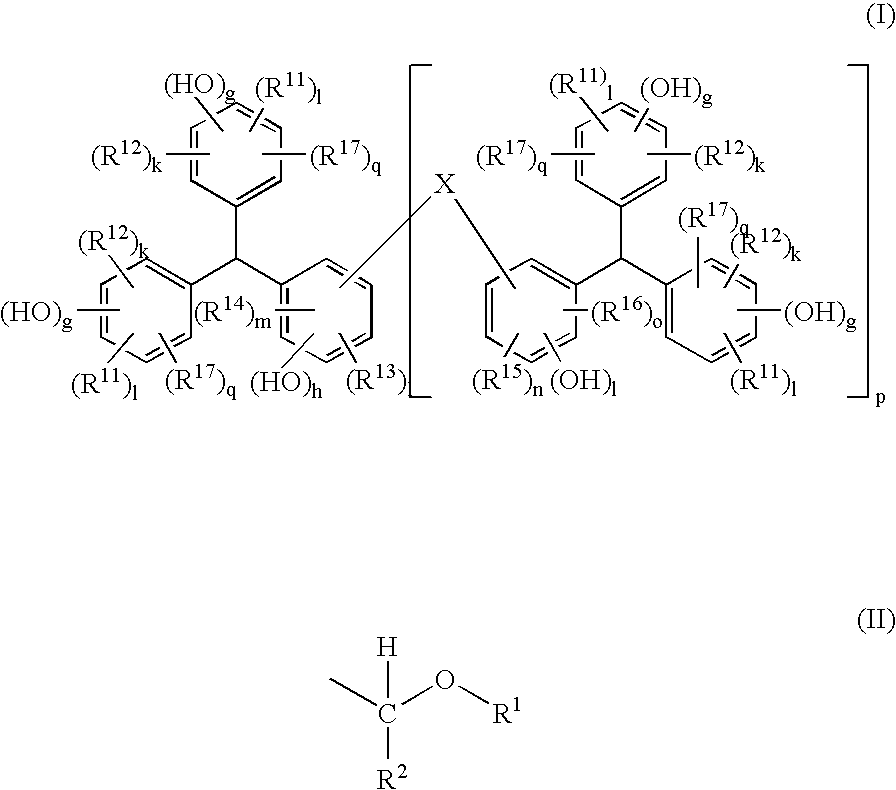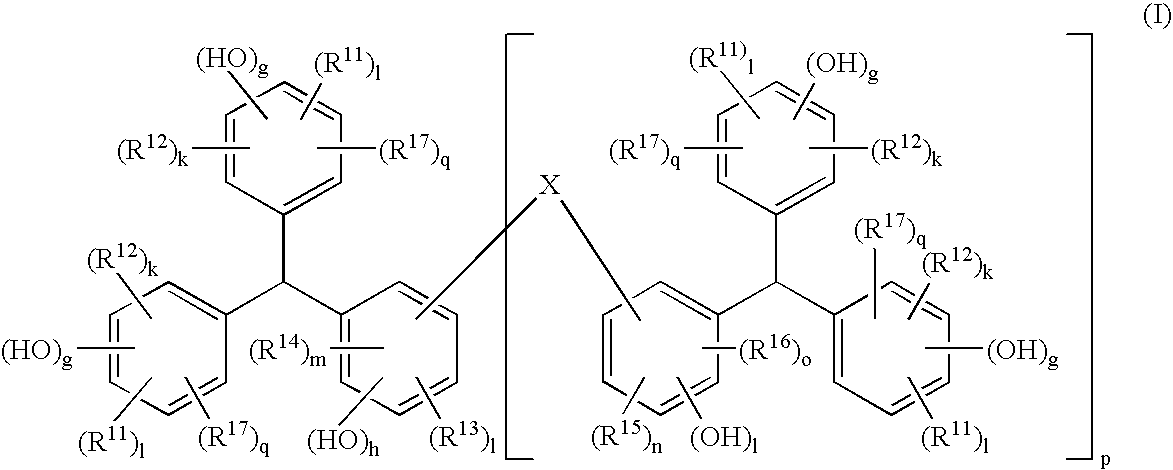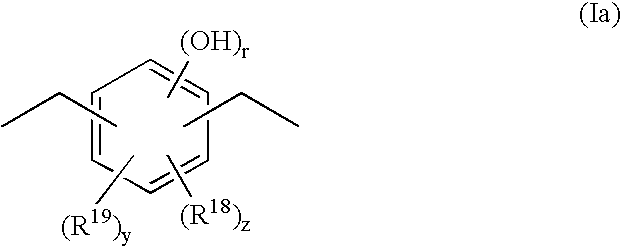Positive Resist Composition, Method For Resist Pattern Formation and Compound
a technology of resist and composition, applied in the field of positive resist composition, can solve the problems of unsatisfactory reduction of inability to satisfactorily maintain the pattern shape, and difficult enabling their practical application, and achieve the effect of reducing the level of roughness and high resolution
- Summary
- Abstract
- Description
- Claims
- Application Information
AI Technical Summary
Benefits of technology
Problems solved by technology
Method used
Image
Examples
synthesis example 1
Synthesis of Precursor Compound
[0176]The precursor compound shown below was synthesized using the procedure described below.
IUPAC Name:
5-({3-[(3-formyl-4-hydroxyphenyl)methyl]-2-hydroxy-5-methylphenyl}methyl)-2-hydroxybenzaldehyde
[0177]Under an atmosphere of nitrogen, 244.0 g (2.0 mol) of salicylaldehyde was weighed into a four-neck flask with a capacity of 1 liter fitted with a reflux condenser, a thermometer and a stirrer, and 244.0 g of a 75% aqueous solution of phosphoric acid was then added dropwise to the flask over a period of 30 minutes and stirred at room temperature. 84.0 g (0.5 mol) of a powdered form of 2,6-bis(hydroxymethyl)-4-methylphenol was then added to the mixed solution intermittently at 60° C. over a 6 hour period, and the resulting mixture was then stirred for a further 17 hours. 366.0 g of methyl isobutyl ketone was then added to the reaction mixture, a phase separation was performed, and the 235.0 g water layer (phase) was removed. The reaction system was then...
synthesis example 2
Synthesis of Compound (1))
[0179]The compound (1) shown below was synthesized using the procedure described below.
IUPAC Name:
4-[(5-{[3-({3-[bis(5-cyclohexyl-4-hydroxy-2-methylphenyl)methyl]-4-hydroxyphenyl}methyl)-2-hydroxy-5-methylphenyl]methyl}-2-hydroxyphenyl)(5-cyclohexyl-4-hydroxy-2-methylphenyl)methyl]-2-cyclohexyl-5-methylphenol
[0180]A four-neck flask was charged with 376.2 g (1.98 mol) of 3-methyl-6-cyclohexylphenol and 92.8 g of methanol, 58.4 g of hydrogen chloride gas was blown into the system at a temperature of 30° C., a further 338.4 g of methanol was added, and 169.2 g (0.45 mol) of the precursor compound obtained in the synthesis example 1 was then added to the reaction system at 40° C. over a period of one hour and 30 minutes to effect a reaction. Subsequently, the reaction was continued by stirring for two hours at 40° C. (crystal precipitation began to occur after stirring for approximately 1 hour).
[0181]Subsequently, the reaction system was neutralized using 400.1...
synthesis example 3
Synthesis of Compound (2)
[0185]10 g of the compound (1) was dissolved in 50 g of tetrahydrofuran (THF), 1.5 g of ethyl vinyl ether was added, and the mixture was stirred at room temperature (r.t.) for 10 hours. Following completion of the reaction, the product was extracted and purified using water / ethyl acetate, and the separated ethyl acetate solution was dried over sodium sulfate and then concentrated under reduced pressure, yielding 9.5 g of a compound (2).
[0186]The protection ratio for the compound (2) (the proportion of the phenolic hydroxyl group hydrogen atoms within the compound (1) that have been substituted with 1-ethoxyethyl groups (as calculated by 1H-NMR)) was 20.1 mol %.
[0187]1H-NMR (deuterated DMSO (deuterated dimethylsulfoxide), internal standard: tetramethylsilane) δ=8.70 to 9.10 (m, 4.65H), 7.77 to 7.91 (m, 0.94H), 6.36 to 7.00 (m, 16H), 5.69 to 5.83 (m, 2H), 5.15 to 5.40 (m, 1.41H), 3.34 to 3.75 (m, 6.81H), 2.58 to 2.85 (m, 4H), 1.90 to 2.19 (m, 15H), 0.88 to 1.8...
PUM
| Property | Measurement | Unit |
|---|---|---|
| roughness | aaaaa | aaaaa |
| molecular weight dispersity | aaaaa | aaaaa |
| dispersity | aaaaa | aaaaa |
Abstract
Description
Claims
Application Information
 Login to View More
Login to View More - R&D
- Intellectual Property
- Life Sciences
- Materials
- Tech Scout
- Unparalleled Data Quality
- Higher Quality Content
- 60% Fewer Hallucinations
Browse by: Latest US Patents, China's latest patents, Technical Efficacy Thesaurus, Application Domain, Technology Topic, Popular Technical Reports.
© 2025 PatSnap. All rights reserved.Legal|Privacy policy|Modern Slavery Act Transparency Statement|Sitemap|About US| Contact US: help@patsnap.com



